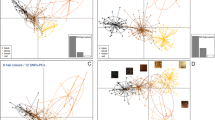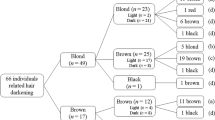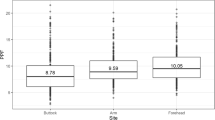Abstract
The Illumina® MiSeq FGx™, in conjunction with the ForenSeq™ DNA Signature Prep kit, produces genotypes of the CODIS-required short tandem repeats and provides phenotype and biogeographical ancestry estimations via phenotype-informative and ancestry-informative markers, respectively. Although both markers have been validated for use in forensic biology, there is little data to determine the practical utility of these estimations to assist in identifying missing persons using decedent casework samples. The accuracy and utility of phenotypic and ancestral estimations were investigated for 300 samples received by the Los Angeles County Department of Medical Examiner-Coroner. piSNP genotypes were translated into hair and eye colors using the Forenseq™ Universal Analysis Software (UAS) on the MiSeq FGx™ and the HIrisPlex System, and statistical accuracy was evaluated in context with the reported decedent characteristics. Similarly, estimates of each decedent’s biogeographical ancestry were compared to assess the efficacy of these markers to predict ancestry correctly. The average UAS and the HIrisPlex system prediction accuracy for brown and blue eyes were 95.3% and 96.2%, respectively. Intermediate eye color could not be predicted with high accuracy using either system. Other than the black hair phenotype reporting an accuracy that exceeded 90% using either system, hair color was also too variable to be predicted with high accuracy. The FROG-kb database distinguishes decedents adequately beyond the Asian, African, European, and Admixed American global ancestries provided by the MiSeq FGx™ UAS PCA plots. FROG-kb correctly identified Middle Eastern, Pacific Islander, Latin American, or Jewish ancestries with accuracies of 70.0%, 81.8%, 73.8%, and 86.7%, respectively.







Similar content being viewed by others
Data availability
Data available upon request.
Code availability
Not applicable.
References
National Research Council (2009) Strengthening forensic science in the United States: a path forward. The National Academies Press, Washington, D.C. https://doi.org/10.17226/12589
Kayser M, de Knijff P (2011) Improving human forensics through advances in genetics, genomics and molecular biology. Nat Rev: Genet 12:179–192. https://doi.org/10.1038/nrg2952
Biesecker LG, Bailey-Wilson JE, Ballantyne J, Baurn H, Bieber FR, Brenner C et al (2005) DNA identifications after the 9/11 World Trade Center attack. Science 310(5751):1122–1123. https://doi.org/10.1126/science.1116608
Butler JM, Coble MD, Vallone PM (2007) STRs vs. SNPs: thoughts on the future of forensic DNA testing. Forensic Sci Med Pathol 3:200–205. https://doi.org/10.1007/s12024-007-0018-1
Walsh S, Liu F, Wollstein A, Kovatsi L, Ralf A, Kosiniak-Kamysz A et al (2013) The HIrisPlex system for simultaneous prediction of hair and eye colour from DNA. Forensic Sci Int Genet 7:98–115. https://doi.org/10.1016/j.fsigen.2012.07.005
Rajeevan H, Soundararajan U, Pakstis AJ, Kidd KK (2012) Introducing the Forensic Research/Reference on Genetics knowledge base. FROG-kb Investigative Genet 3(18):1–8. https://doi.org/10.1186/2041-2223-3-18
Bulbul O, Cherni L, Khodjet-el-khil H, Rajeevan H, Kidd KK (2016) Evaluating a subset of ancestry informative SNPs for discriminating among Southwest Asian and circum-Mediterranean populations. Forensic Sci Int Genet 23:153–158. https://doi.org/10.1016/j.fsigen.2016.04.010
Gettings KB, Lai R, Johnson JL, Peck MA, Hart JA, Gordish-Dressman H et al (2014) A 50-SNP assay for biogeographic ancestry and phenotype prediction in the U.S. population. Forensic Sci Int Genet 8:101–108. https://doi.org/10.1016/j.fsigen.2013.07.010
Kidd KK, Speed WC, Pakstis AJ, Furtado MR, Fang R, Madbouly A et al (2014) Progress toward an efficient panel of SNPs for ancestry inference. Forensic Sci Int Genet 10:23–32. https://doi.org/10.1016/j.fsigen.2014.01.002
Promega Corporation (2008) Maxwell 16® Instrument (AS2000) Operating Manual. Madison. p.35
MiSeq FGxTM Internal Validation. Los Angeles, California: Los Angeles County of Medical Examiner-Coroner, Human Genomics Unit
ForenSeqTM DNA Signature Prep Reference Guide (2015) Catalog #TG-450-9001, DOC. Material #20000923, Document #15049528 v01. Illumina, Inc, San Diego
Department of Genetic Identification of Erasmus MC, Rotterdam, The Netherlands (2018) HIRISPLEX-S, HIRISPLEX & IRISPLEX Eye, Hair and Skin colour DNA Phenotyping webtool USER MANUAL. p. 7–9, 15–22. Retrieved from https://hirisplex.erasmusmc.nl/pdf/hirisplex.erasmusmc.nl.pdf
Forensic Resource/Reference on Genetics—knowledge base: FROG-kb user's manual (2017) Retrieved from http://frog.med.yale.edu/FrogKB/manual/userManual_V3.pdf
Liu F, van Duijn K, Vingerling JR, Hofman A, Uitterlinden AG, Cecile A et al (2009) Eye color and the prediction of complex phenotypes from genotypes. Current Bio 19(5):R192–R193. https://doi.org/10.1016/j.cub.2009.01.027
Walsh S, Chaitanya L, Clarisse L, Wirken L, Draus-Barini J, Kovatsi L et al (2014) Developmental validation of the HIrisPlex system: DNA-based eye and hair colour prediction for forensic and anthropological usage. Forensic Sci Int Genet 9:150–161. https://doi.org/10.1016/j.fsigen.2013.12.006
Ruiz Y, Phillips C, Gomez-Tato A, Alvarez-Dios J, de Cal C, Cruz R et al (2012) Further development of forensic eye color predictive tests. Forensic Sci Int Gen 7:28–40. https://doi.org/10.1016/j.fsigen.2012.05.009
Kayser M (2015) Forensic DNA phenotyping: predicting human appearance from crime scene material for investigative purposes. Forensic Sci Int: Genet 18:33–48. https://doi.org/10.1016/j.fsigen.2015.02.003
Spichenok O, Budimlija ZM, Mitchell AA, Jenny A, Kovacevic L, Marjanovic D (2011) Prediction of eye and skin color in diverse populations using seven SNPs. Forensic Sci Int Genet 5:472–478. https://doi.org/10.1016/j.fsigen.2010.10.005
Walsh S, Wollstein A, Liu F, Chakravarthy U, Rahu M, Seland JH et al (2012) DNA-based eye colour prediction across Europe with the IrisPlex system. Forensic Sci Int Genet 6:330–340. https://doi.org/10.1016/j.fsigen.2011.07.009
Branicki W, Liu F, van Duijn K, Draus-Barini J, Pospiech E, Walsh S et al (2011) Model-based prediction of human hair color using DNA variants. Hum Genet 129:443–454. https://doi.org/10.1007/s00439-010-0939-8
Sulem P, Gudbjartsson DF, Stacey SN, Helgason A, Rafnar T, Magnusson KP et al (2007) Genetic determinants of hair, eye and skin pigmentation in Europeans. Nature Gen 39(12):1443–1452. https://doi.org/10.1038/ng.2007.13
Pardo-Seco J, Martinon-Torres F, Salas A (2014) Evaluating the accuracy of AIM panels at quantifying genome ancestry. BMC Genom 15(543):1471–2164. https://doi.org/10.1186/1471-2164-15-543
Palencia-Madrid L, Xavier C, De la Puente M, Hohoff C, Phillips C, Kayser M et al (2020) Evaluation of the VISAGE basic tool for appearance and ancestry prediction using PowerSeq chemistry on the MiSeq FGx System. Genes 11(6):708. https://doi.org/10.3390/genes11060708
Xavier C, De la Puente M, Mosquera-Miguel A, Freire-Aradas A, Kalamara V, Vidaki A et al (2020) Development and validation of the VISAGE AmpliSeq Basic Tool to predict appearance and ancestry from DNA. Forensic Sci Int Genetics 48:102336. https://doi.org/10.1016/j.fsigen.2020.102336
Lao O, de Gruijter JM, van Duijn K, Navarro A, Kayser M (2007) Signatures of positive selection in genes associated with human skin pigmentation as revealed from analyses of single nucleotide polymorphisms. Annals of Human Gen 71:354–369. https://doi.org/10.1111/j.1469-1809.2006.00341.x
Myles S, Somel M, Tang K (2007) Identifying genes underlying skin pigmentation differences among human populations. Hum Genet 120:613–621. https://doi.org/10.1007/s00439-006-0256-4
Hillmer AM, Brockschmidt FF, Hanneken S, Eigelshoven S, Steffens M, Flaquer A et al (2008) Susceptibility variants for male-pattern baldness on chromosome 20pll. Nature Gen 40(11):1279–1281. https://doi.org/10.1038/ng.228
Estrada K, Krawczak M, Schreiber S, van Duijn K, Stolk L, van Meurs JBJ et al (2009) A genome-wide association study of northwestern Europeans involves the C-type natriuretic peptide signaling pathway in the etiology of human height variation. Hum Mol Genet 18(18):3516–3524. https://doi.org/10.1093/hmg/ddp296
Genetic Investigation of Anthropocentric Traits (GIANT) Consortium (2010) Hundreds of variants clustered in genomic loci and biological pathways affect human height. Nature 467:832–838. https://doi.org/10.1038/nature09410
Medland SE, Nyholt DR, Painter JN, McEvoy BP, McRae AF, Zhu G et al (2009) Common variants in the trichohyalin gene are associated with straight hair in Europeans. Amer J of Human Genet 85:750–755. https://doi.org/10.1016/j.ajhg.2009.10.009
Fujimoto A, Kimura R, Ohashi J, Omi K, Yuliwulandari R, Batubara L et al (2008) A scan for genetic determinants of human hair morphology: EDAR is associated with Asian hair thickness. Hum Mol Gen 17(6):835–843. https://doi.org/10.1093/hmg/ddm335
Zubakov D, Liu F, van Zelm MC, Vermeulen J, Oostra BA, van Duijn CM et al (2010) Estimating human age from T-cell DNA rearrangements. Current Bio 20(22):R970–R1. https://doi.org/10.1016/j.cub.2010.10.022
Correia Dias H, Cordeiro C, Corte Real F, Cunha E, Manco L (2019) Age estimation based on DNA methylation using blood samples from deceased individuals. J For Sci 65(2):465–470. https://doi.org/10.1111/1556-4029.14185
Heidegger A, Xavier C, Niederstätter H, De la Puente M, Pośpiech E, Pisarek A et al (2020) Development and optimization of the VISAGE basic prototype tool for forensic age estimation. Forensic Sci Int: Genetics 48:102322. https://doi.org/10.1016/j.fsigen.2020.102322
Montesanto A, D’Aquila P, Lagani V, Paparazzo E, Geracitano S, Formentini L et al (2020) A new robust epigenetic model for forensic age prediction. J For Sci 65(5):1424–1431. https://doi.org/10.1111/1556-4029.14460
Young JM, Power D, Kanokwongnuwut P (2020) Ancestry and phenotype predictions from touch DNA using massively parallel sequencing. Int J Legal Med. https://doi.org/10.1007/s00414-020-02398-7
Acknowledgements
From the Los Angeles County Department of Medical Examiner-Coroner, the authors wish to thank Dr. Ruby Javed-Ghaffar, the Chief of the Forensic Labs, Mr. Eric Wahoske, the previous supervisor of the Human Genomics Unit, and Sarah de Quintana, who served as the Chair of the Research and Publication Committee during this project, for providing approval for the use of postmortem blood samples. Also, we would like to acknowledge and thank DNA Analyst, Oscar Pleitez, for sharing in the training of Ms. Weisz and for helping with the logistics of charging in and out the postmortem blood samples. The authors want to extend thanks to Verogen for reagents and for the scientific collaboration provided by Ann Allison, John Walsh, Melissa Kotkin, Meghan Didier, and Cydne Holt in data review.
Author information
Authors and Affiliations
Corresponding author
Ethics declarations
Ethics approval
The LACDoME-C Research and Publication Committee approved this study before initiating the research. The use of decedent samples is permitted to validate new technologies and analysis methods at the LACDoME-C. The results for all samples utilized in this study were reported without personal identifying information (PII) other than the decedent’s hair and eye color and biogeographical ancestry. Living subjects gave informed consent for the collection and use of their buccal swabs for research purposes. All samples were coded to provide confidentiality.
Consent to participate
Include appropriate statements.
Consent for publication
Not applicable.
Conflict of interest
The authors declare no competing interests.
Additional information
Publisher's note
Springer Nature remains neutral with regard to jurisdictional claims in published maps and institutional affiliations.
Supplementary Information
Below is the link to the electronic supplementary material.
414_2021_2631_MOESM2_ESM.pdf
Supplementary file2 (PDF 166 KB) EMS 2 (LACDoME-C HGU-004 Analysis and Interpretation of Plexor HY Quantification Assay).
Rights and permissions
About this article
Cite this article
Weisz, N.A., Roberts, K.A. & Hardy, W.R. Reliability of phenotype estimation and extended classification of ancestry using decedent samples. Int J Legal Med 135, 2221–2233 (2021). https://doi.org/10.1007/s00414-021-02631-x
Received:
Accepted:
Published:
Issue Date:
DOI: https://doi.org/10.1007/s00414-021-02631-x




